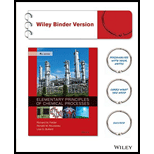
A liquid-phase chemical reaction with stoichiometry A ? B takes place in a semibatch reactor. The rate of consumption of A per unit volume of the reactor contents is given by the first-order rate expression (see Problem 10.19)
where CA(mol A/L) is the reactant concentration. The tank is initially empty. Beginning at a time t = 0, a solution containing A at a concentration CA0(mol A/L) is fed to the tank at a constant rate
Write a differential balance on the total mass of the reactor contents. Assuming that the density of the contents always equals that of the feed stream, convert the balance into an equation for dV/dt, where V is the total volume of the contents, and provide an initial condition. Then write a differential mole balance on the reactant. A, letting NA(t) equal the total moles of A in the vessel, and provide an initial condition. Your equations should contain only the variables (VA, V, and t and the constants
- and CA0. (You should be able to eliminate CAas a variable.)
- Without attempting to integrate the equations, derive a formula for the steady-state value of NA.
Want to see the full answer?
Check out a sample textbook solution
Chapter 10 Solutions
Elementary Principles of Chemical Processes, Binder Ready Version
Additional Engineering Textbook Solutions
Elements of Chemical Reaction Engineering (5th Edition) (Prentice Hall International Series in the Physical and Chemical Engineering Sciences)
Process Dynamics and Control, 4e
C++ How to Program (10th Edition)
Starting Out with C++ from Control Structures to Objects (9th Edition)
Introductory Circuit Analysis (13th Edition)
Engineering Mechanics: Statics & Dynamics (14th Edition)
 Introduction to Chemical Engineering Thermodynami...Chemical EngineeringISBN:9781259696527Author:J.M. Smith Termodinamica en ingenieria quimica, Hendrick C Van Ness, Michael Abbott, Mark SwihartPublisher:McGraw-Hill Education
Introduction to Chemical Engineering Thermodynami...Chemical EngineeringISBN:9781259696527Author:J.M. Smith Termodinamica en ingenieria quimica, Hendrick C Van Ness, Michael Abbott, Mark SwihartPublisher:McGraw-Hill Education Elementary Principles of Chemical Processes, Bind...Chemical EngineeringISBN:9781118431221Author:Richard M. Felder, Ronald W. Rousseau, Lisa G. BullardPublisher:WILEY
Elementary Principles of Chemical Processes, Bind...Chemical EngineeringISBN:9781118431221Author:Richard M. Felder, Ronald W. Rousseau, Lisa G. BullardPublisher:WILEY Elements of Chemical Reaction Engineering (5th Ed...Chemical EngineeringISBN:9780133887518Author:H. Scott FoglerPublisher:Prentice Hall
Elements of Chemical Reaction Engineering (5th Ed...Chemical EngineeringISBN:9780133887518Author:H. Scott FoglerPublisher:Prentice Hall
 Industrial Plastics: Theory and ApplicationsChemical EngineeringISBN:9781285061238Author:Lokensgard, ErikPublisher:Delmar Cengage Learning
Industrial Plastics: Theory and ApplicationsChemical EngineeringISBN:9781285061238Author:Lokensgard, ErikPublisher:Delmar Cengage Learning Unit Operations of Chemical EngineeringChemical EngineeringISBN:9780072848236Author:Warren McCabe, Julian C. Smith, Peter HarriottPublisher:McGraw-Hill Companies, The
Unit Operations of Chemical EngineeringChemical EngineeringISBN:9780072848236Author:Warren McCabe, Julian C. Smith, Peter HarriottPublisher:McGraw-Hill Companies, The





